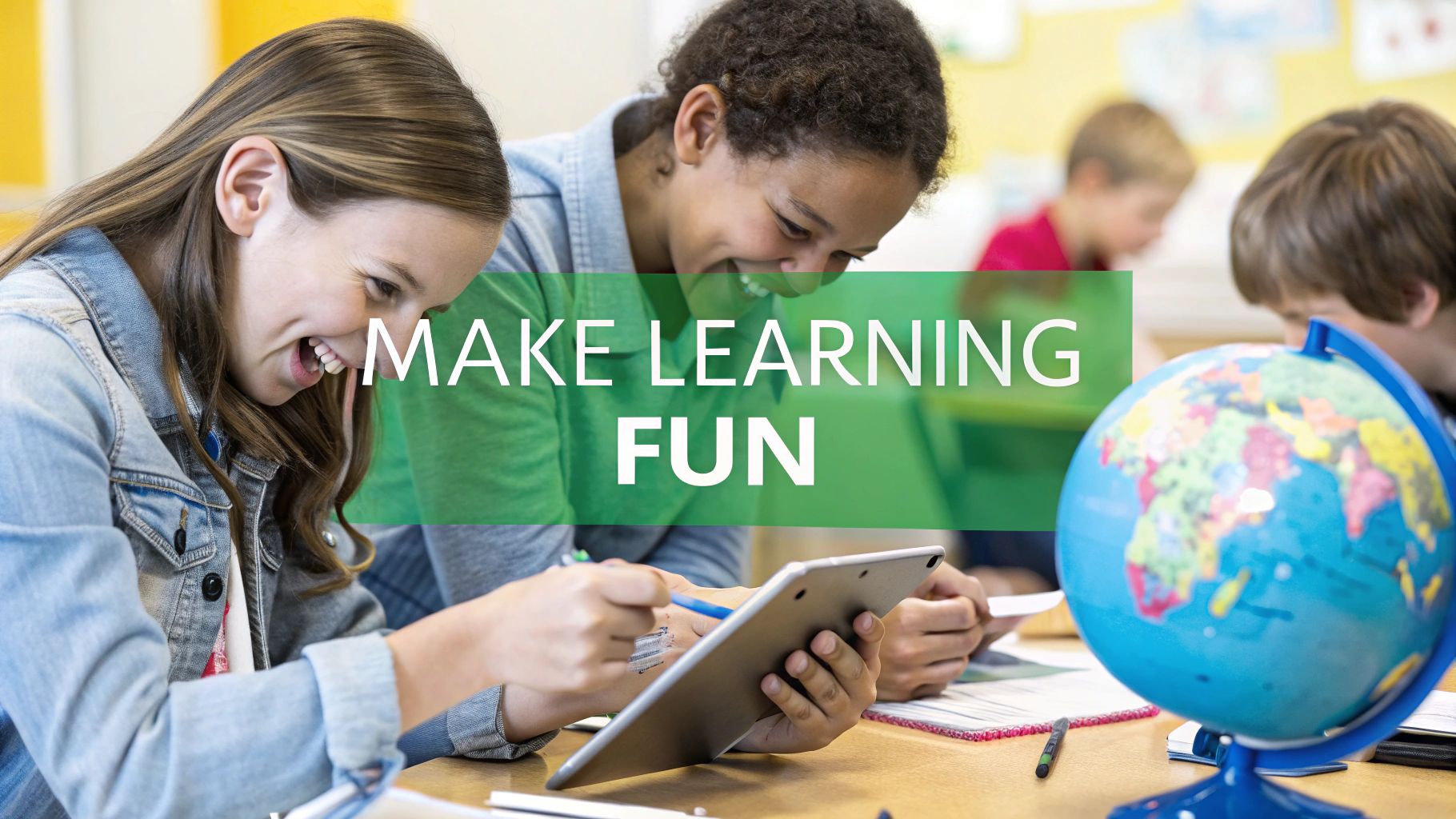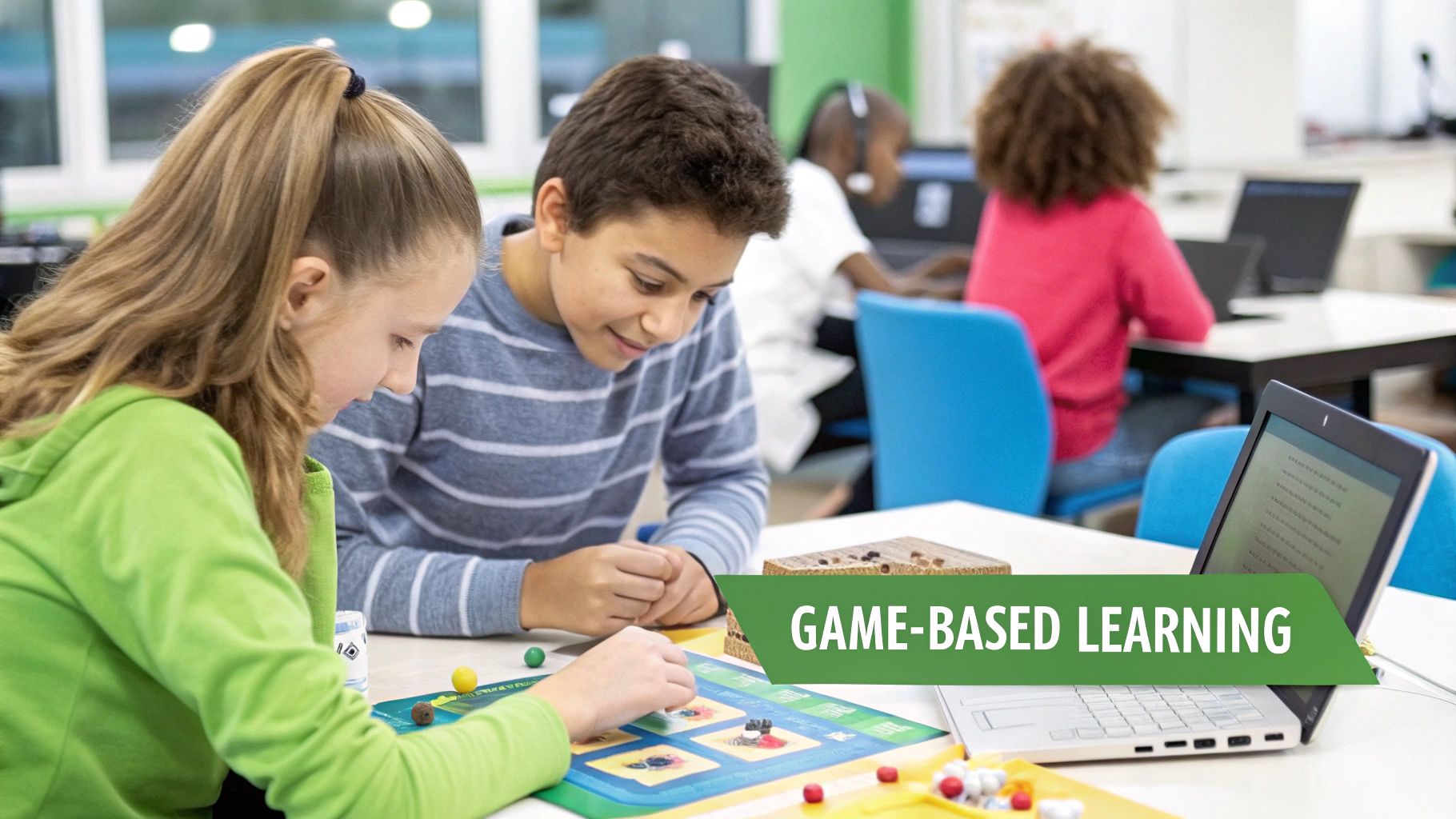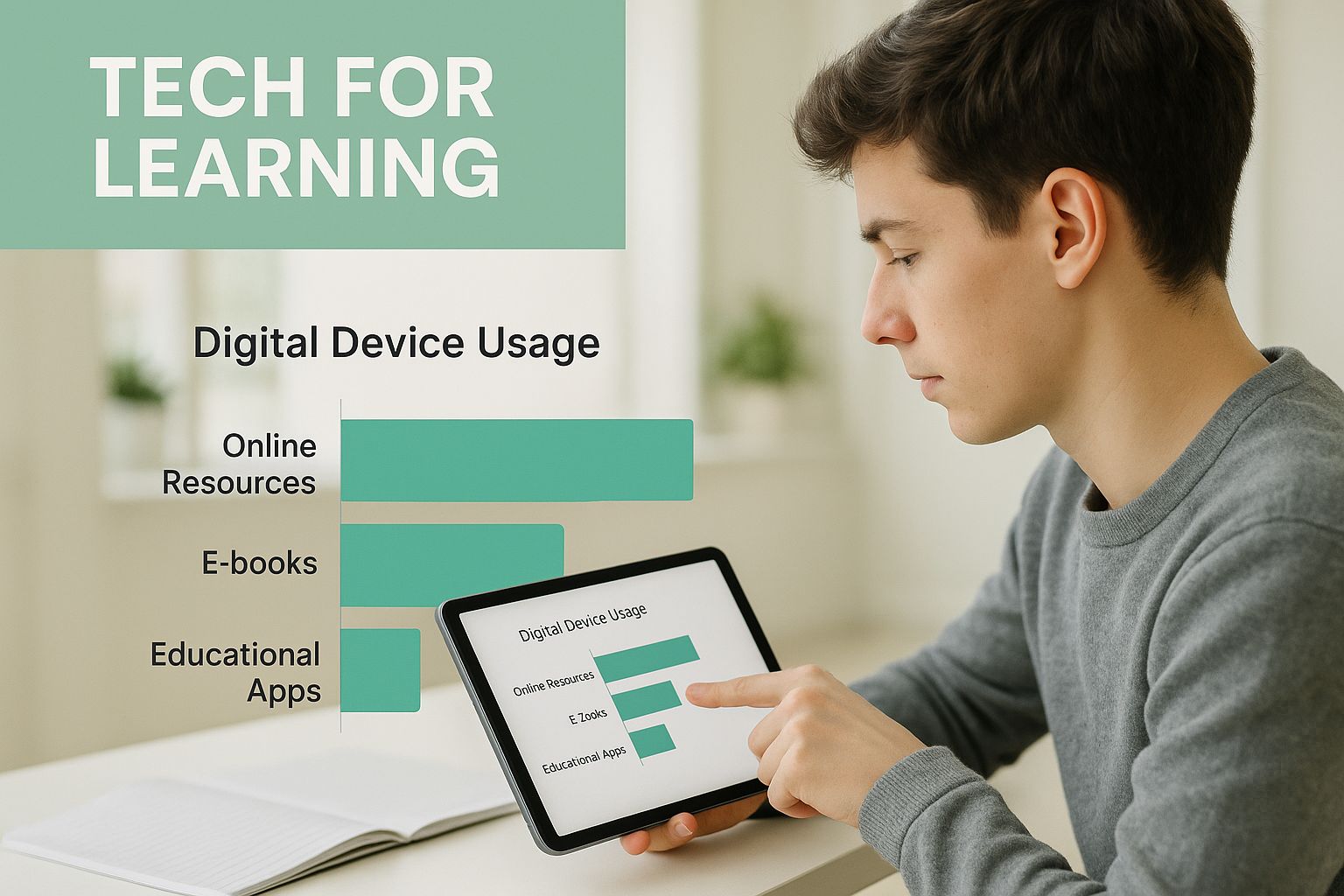How to Make Learning Fun for Lasting Results
Discover how to make learning fun with proven, engaging strategies for educators and parents. Transform any subject into an adventure that students will love.

Making learning fun isn’t just about slapping a game onto a boring lesson. It’s about a fundamental shift in how we approach education—moving from passive memorization to active, joyful discovery. The real magic happens when you connect a subject to a student's natural curiosity. That’s when a lesson becomes an experience they actually want to be part of.
Why Fun Learning Is a Non-Negotiable

Let's get one thing straight: fun isn't just a "nice-to-have" in the classroom. It's an essential ingredient for learning that sticks. When a student is truly engaged and having a good time, their brain chemistry literally changes.
Engaging, enjoyable activities trigger a release of dopamine, the neurotransmitter tied to motivation and memory. This little chemical reward system tells the brain to pay closer attention and helps cement new information.
Think of it this way: a brain under stress is focused on survival, not on absorbing complex ideas. A brain experiencing joy and curiosity is open, receptive, and primed for learning.
This positive state melts away the anxiety that so often comes with tough subjects. It creates a safe space where students feel comfortable taking risks, making mistakes, and ultimately, finding success. The classroom transforms from a place of pressure into a place of possibility.
The Impact on Engagement and Retention
The benefits here go way beyond a single good lesson. Creating a positive and fun learning environment has a direct, measurable impact on everything from attendance to long-term academic success.
When learning feels like a chore, disengagement is almost guaranteed. This isn't a small problem—it's a global one. In 2021, an estimated 244 million children and youth were out of school. While countless factors are at play, building learning environments that are genuinely enjoyable and relevant is a massive piece of the puzzle. You can dig into more of these global education statistics from UNESCO.
This isn't about constant entertainment. It's about building a durable, positive relationship with learning itself. When students associate education with discovery and achievement, they are far more likely to:
- Show up consistently: They actually look forward to participating in activities they enjoy.
- Understand concepts deeply: Active, joyful learning encourages critical thinking, not just memorizing for a test.
- Develop a lifelong passion: Positive early experiences are the foundation for becoming a curious, continuous learner.
At the end of the day, making learning fun is a strategic move. It's how we build more resilient, curious, and successful learners for life.
Turn Lessons into Games
Gamification is so much more than just slapping a point system or a leaderboard onto a lesson. At its core, it's about tapping into the things that make us human—our drive for achievement, a bit of healthy competition, and the thrill of solving a good puzzle.
When you frame a lesson as a game, you completely change the dynamic. It stops being a passive lecture and becomes an active challenge, something students actually want to conquer. This simple shift is one of the most powerful tools we have for making learning genuinely fun.
How to Think Like a Game Designer
Forget boring drills. What if you turned a history chapter into a detective mystery? Give students primary source documents—old letters, maps, diary entries—and let them piece together the clues to figure out the real motivations behind a major historical event. Suddenly, the "win condition" isn't about memorizing dates; it's about building a compelling case from evidence.
This is where technology can be an incredible ally.

As you can see, blending digital tools into the classroom makes the entire experience more interactive and accessible for everyone.
Building Your Own Learning Game
You don't need fancy software to get started. Just begin with a clear learning goal and build the "game" around it. The real secret is creating a structure that sparks that internal desire to succeed.
Take a standard math worksheet. It's functional, but not very exciting. Now, what if you turned it into a "Math Quest"? Every correctly solved problem unlocks the next "level" or reveals another piece of a hidden map. This gives students an immediate sense of progress and accomplishment, which feels way better than getting a red checkmark.
The most important part of any game is a good feedback loop. When you play, you know instantly if you succeeded or failed, and you can try again right away. This kind of low-stakes, immediate feedback builds persistence and true mastery.
You can apply these game mechanics to pretty much any subject you can think of. Here are a few ideas to get you started:
- Science: A "potion-making" lab where students have to correctly mix "ingredients" (safe household items, of course) to create a specific chemical reaction.
- Language Arts: An "escape room" where teams solve grammar puzzles and vocabulary riddles to find clues that unlock the door.
- Geography: Instead of memorizing capitals, design a world-traveling adventure. Digital tools make this incredibly immersive. For a great example of this in action, check out EarthChasers’ 3D geography game, which turns exploration into a core part of the fun.
Applying Gamification Elements Across Subjects
To make this even more practical, let's look at how specific game mechanics can be applied to different school subjects. This isn't about just one-off activities; it's about weaving these elements into your regular curriculum to keep engagement high.
| Gamification Element | Application in Math/Science | Application in Humanities/Arts | Key Benefit |
|---|---|---|---|
| Points & Badges | Award points for solved equations or badges for mastering lab safety. | Give badges for identifying 5 literary devices or points for historical accuracy. | Provides immediate, tangible rewards for effort and achievement. |
| Levels & Progression | A series of increasingly difficult physics problems, moving from "Apprentice" to "Master." | Students "level up" from analyzing a single poem to an entire author's collection. | Creates a clear path of mastery and shows students how far they've come. |
| Quests & Challenges | A multi-step "Quest to Build a Circuit" with specific material constraints. | A "Historical Investigation" quest to uncover the truth behind a famous event. | Turns learning objectives into engaging, story-driven missions. |
| Leaderboards | A class leaderboard for the fastest time solving a set of chemistry problems (optional). | A leaderboard tracking who has read the most pages or visited the most "virtual" museums. | Fosters friendly competition and can motivate students who thrive on it. |
By weaving these elements into your lessons, you're not just adding a layer of fun; you're fundamentally changing how students approach learning.
When you frame learning as a game, you're doing more than just entertaining. You’re teaching crucial life skills like critical thinking, collaboration, and resilience. Students learn to see a challenge not as a barrier, but as an opportunity to learn, adapt, and try a new strategy.
Use Technology for Interactive Exploration
Technology, when used right, can completely reshape the learning experience. I'm not talking about replacing teachers or traditional methods, but about adding a layer of immersion that just wasn't possible before. It’s a game-changer for making learning genuinely fun.
Don't just hand a student a tablet and call it a day. Think of technology as a portal. With Augmented Reality (AR), a human skeleton can spring to life on the classroom floor. Virtual Reality (VR) can drop students right into the middle of ancient Rome. These aren't just gadgets; they're tools that make abstract concepts feel real and tangible.
Personalizing the Learning Journey
One of the best things about modern educational tech is its ability to adapt. AI-driven platforms can adjust challenges to match each student's pace, which is huge. It keeps them in that sweet spot of being engaged without feeling overwhelmed or bored. This is so important for building confidence.
A 2023 global survey really drove this point home. Out of over 6,100 participants, a recurring theme was the need for learning programs that can adapt. The report noted that AI is gaining traction precisely because it can personalize the educational experience, which directly fuels student engagement. You can dig into more of these trends in this student engagement and success report.
When you meet students exactly where they are, you eliminate the frustration of feeling left behind or the boredom of waiting for others. It just creates a more positive, effective learning environment for everyone.
Creating Immersive Adventures
Beyond individual tools, online platforms can create entire adventures. Imagine an environmental science class where students don't just read about ecosystems—they actively manage a virtual one together.
Platforms like EarthChasers are built on this idea of hands-on exploration. It turns learning geography from memorizing facts into an actual journey.

This shot from EarthChasers shows how a 3D, interactive world makes exploring the globe feel like a game. It's that blend of stunning visuals and solid educational content that sparks real curiosity and a drive to discover.
Using tools like this, you can design quests and challenges that require teamwork, critical thinking, and problem-solving—skills that stick. This approach makes learning memorable and forges a strong link between classroom knowledge and a sense of real-world adventure. If you're looking for more ways to make geography exciting, check out our guide on how to learn world geography.
Connect Learning to Real-World Problems
Embedded content
Nothing kills a kid's curiosity faster than the dreaded question, "When are we ever going to use this?" It’s a fair question. When lessons feel like they exist only inside a textbook, they become abstract chores, not valuable tools for life.
The secret to making learning stick—and making it fun—is to bridge that gap. We need to show learners that education isn't just for the classroom; it's a toolkit for understanding and navigating the world.
The most powerful lightbulb moments happen when students see how their knowledge can be used to understand, interact with, and even change the world around them. It transforms them from passive listeners into active problem-solvers.
This shift gives their efforts a real, tangible purpose. They're no longer just memorizing formulas; they're using them to figure something out.
From Abstract to Actionable
Making these connections doesn't require a massive curriculum overhaul. It's often about reframing the concepts you're already teaching. A few simple, relatable projects can bring almost any subject to life.
Here are a few ideas to get you started:
- Financial Literacy: Forget abstract percentages. Have students create a real household budget. They can track expenses, set savings goals, and see firsthand how interest rates work.
- Physics in Action: Take physics out of the textbook and onto the court. Analyze the arc of a basketball shot or the force behind a soccer kick. Suddenly, those laws of motion make perfect sense.
- Civic Engagement: Turn a local community issue into a project-based learning opportunity. Students could research a problem, propose solutions, and maybe even present their ideas to local leaders.
When students apply their skills to solve problems they actually care about, the motivation comes from within. It’s no longer about getting a grade. This kind of engagement is what builds skills that truly matter for their future.
Globally, every extra year of schooling can boost earnings by about 10%, but if students aren't engaged, they miss out. Making learning meaningful is how we help them adapt to a changing job market and avoid becoming part of the 24% of youth not in employment, education, or training. You can find more insights on the economic impact of education from The World Bank.
Ultimately, linking what’s learned in the classroom to the world outside is how you make learning fun in a way that truly lasts.
Empower Students with Choice and Creativity
Handing learners the reins to their own education is one of the most effective ways to make learning stick. It's a game-changer. When students get a say in how they learn, the whole dynamic shifts from a chore they have to complete into something they’re genuinely invested in.
This doesn't mean you throw the curriculum out the window. It's about offering different paths to get to the same learning destination. Instead of the default five-paragraph essay, what if students could choose how to show what they know?
Autonomy builds ownership. When students feel their choices matter, they become far more invested in the outcome and are more likely to create work they are truly proud of.
This single shift can transform the classroom from a top-down lecture hall into a collaborative workshop. It tells students you respect their unique talents and interests, which is a massive motivator for anyone.
Foster Curiosity with Open-Ended Projects
One of the best ways to put choice into action is through open-ended projects. You provide the core topic and a clear, simple rubric, but the how is left up to them.
For instance, after a unit on world biomes, you could put a few options on the table:
- Write a short story from the perspective of an animal living there.
- Create a short documentary showcasing the biome's most fascinating features.
- Design a travel brochure trying to convince tourists to visit (or maybe avoid!) the area.
- Build a diorama that brings the ecosystem's plants and animals to life.
Giving them this kind of creative freedom allows students to connect with the material in a way that makes sense to them. It also lets them lean into their passions. A student who loves gaming might even design their own quiz—inspired by the kinds of questions in this geography quiz game—to test their classmates' knowledge. That flexibility is what makes learning not just more rewarding, but far more memorable.
Frequently Asked Questions About Fun Learning
Even with the best intentions, parents and educators often hit a few roadblocks when trying to make learning more engaging. Let's tackle some of the most common questions head-on with some practical, real-world advice to help you get started with confidence.
How Can I Make Learning Fun on a Tight Budget?
This one comes up a lot, and the answer is simpler than you think. You don't need a pile of expensive gadgets or fancy subscription boxes to spark curiosity. Honestly, your most powerful tools are totally free: creativity and imagination.
Turn everyday household items into a science lab. An old egg carton can become the perfect base for a craft project about crabs, teaching a bit of biology and fine motor skills at the same time. Got a review session coming up? Turn it into a board game with some handmade flashcards. The focus should always be on resourcefulness, not spending.
The real magic happens when a child helps create the game or experiment. When they’re part of the process, their investment in the outcome skyrockets, and the learning sticks in a way that just doesn't happen with a worksheet.
Will Making Learning Fun Lower Academic Standards?
It's a common fear, but the reality is just the opposite. When done right, fun learning methods actually raise academic standards because they demand a much deeper level of engagement.
Think about it. Gamification and project-based learning aren't about memorizing and spitting back facts. They require critical thinking, problem-solving, and applying knowledge in new ways. When students are genuinely motivated, they're far more likely to dig deeper into a topic on their own, leading to a much more profound understanding. The goal isn't to water down the material; it's to make rigorous content exciting and accessible.
How Do I Balance Fun Activities with Curriculum Requirements?
The key here is integration, not addition. Stop thinking of fun activities as one more thing you have to squeeze into an already packed schedule. Instead, look for ways to design engaging experiences that directly teach and reinforce the required curriculum.
For example, instead of a dry lecture on historical analysis, you could create a "History Detective" game. Students would need to use primary sources to solve a mystery, directly hitting a specific learning objective. A single, well-designed project can often cover multiple curriculum points at once. By aligning the fun with your educational goals, you meet all the requirements while boosting retention and student performance. It's a win-win.
Ready to turn geography lessons into an unforgettable adventure? Discover how EarthChasers uses a stunning 3D world to make learning about our planet an exciting quest. Start exploring at EarthChasers.com.
